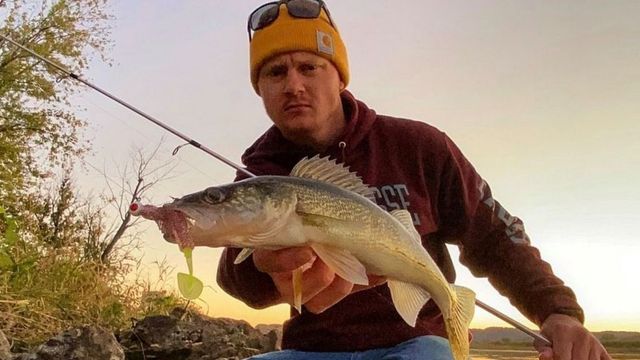
The Ultimate Guide To Catching Walleye In The Fall
By: Ben Patschull from Old Style Angling
With all of the distractions that the fall season brings, fishing can be swept aside as outdoorsmen trade in their rods and reels for shotguns and bows. However, as water temperatures cool and baitfish begin to gather in schools near shore, fall can deliver some of the most productive walleye bites of the year.
Location and Timing For Catching Walleye In The Fall
The author with fall walleye pulled from the Mississippi River
Fall fish can exhibit more unpredictable behavior than pre and post-spawn spring fish. Still, patterns can be pieced together by paying close attention to water temperature and fishing at the best times of the day. I always start my search by locating rocky shorelines in around ten feet of water. When water temperatures fall below 60 degrees, baitfish will start to school in these rocky areas, especially around current breaks and structure. Just like the forward-thinking homeowner stocking up on sidewalk salt and firewood for the coming winter, walleyes and other predatory fish will gorge on groups of shad, shiners, and other baitfish in preparation for the colder months to come. Don’t let the decreasing temperatures and adverse conditions prevent you from wetting a line; I have found that the poorest weather can summon the highest fish activity during the fall. Finally, although walleyes can be found in many of the same locations as spring fish, their feeding windows are more time-dependent. Walleyes can be caught anytime, but the hour before and after dark consistently holds the best bites.
Baits and Rigs That Slay Fall Walleye
Having live bait can make a big difference when chasing fall walleye
Live bait plays just as important of a role in my fall walleye fishing as it does during the other three seasons. Nightcrawlers are my choice live bait when water temperatures are still above 55 degrees, and as the temperature creeps below this mark, I transition to mainly using minnows.
Although there are hundreds of options for rigging live bait, I use two rigs almost exclusively in the fall. A simple three-way rig is my go-to for both crawlers and minnows, especially when fishing from shore. My three-way rigs consist of a small three-way swivel tied off to a 15-pound braid mainline, about 6 inches of 8 to 10-pound fluoro with a VMC live bait hook, and one foot of 6-pound fluoro tied off to an egg sinker.
To reduce three-way rig frustration, an important note: always make sure your sinker leader-line is longer than your hook leader-line to fend off those annoying tangles. The second rig that I use primarily for minnows is the criminally under-utilized slip-float rig. I use this style of rig when I am fishing areas with an exceptionally rough bottom structure, where three-way rigs are unusable. Although both of these rigs are among the simplest presentations, I find that many anglers avoid the three-way and slip-float rigs due to the hassle of stringing together the multiple components each time they want to change their offering. To avoid this inconvenience, I dedicate a rod to each of these individual rigs so I always have one available whenever I hit the water.
Live bait may be the technique that contributes the highest numbers of fall walleyes, but artificial baits produce the biggest trophies. Popping a VMC darter head jig with a paddle tail style plastic (example: BFishn Pulse-R) or a classic round jig head with a grub tail style plastic (example: BFishin Ringworm) are staples in my fall walleye fishing. For fishing at night, trolling crankbaits in 8 to 15 feet of water around rocky points or wing dams can be effective. Using jig heads with built-in rattles in nearshore areas less than 10 feet can also effectively catch late-night walleyes in the fall.
Updated October 22nd, 2021 at 7:40 AM CT
